The word geography comes from two Greek words: “geo”, which means earth, and “graphs”, which means description.
When we think of geography, we often use the following words or concepts: location, site, place, access, spatial, regional, distance, separation, proximity, speed, mobility, transportation, resources, communication, agglomeration, etc.
A quick and simple definition of Geography thus may be: “the study of how society organizes itself in space”.
Geography is a field of study that is primarily concerned with variation from place to place rather than from time to time and lets us understand the relationship among places along with integrated themes.
Therefore, geography studies spatial variations on the earth’s surface. Here the earth’s surface refers to the milieu (social environment) in which human life exists, i.e., the lower portion of the atmosphere which people breathe; the outer part of the lithosphere, upon which people walk and from which minerals are extracted, and the hydrosphere where people fish and sail.
Finally, geography is the discipline that analyzes and explains variations in activities over space. So, its better name is spatial science.
Economic Geography
- Our attempt to combine the definitions of Economics and Geography may become a little messy, but let us try:
- “In Economic Geography, we study the (locational, organizational and behavioral) principles and processes associated with the spatial allocation of scarce (human, man-made and natural) resources (which are also distributed spatially) and the spatial patterns and (direct and indirect, social, environmental and economic) consequences resulting from such allocations.
- Let’s try a shorter version: “Economic geographers study the principles governing the spatial allocation of resources and the resulting consequences.
Economic geography studies spatial variation on the earth’s surface of activities related to producing, exchanging, and consuming goods and services.
It provides/gives a conceptual understanding of the changing fortunes of the world economy.
- Economic geography is a branch of geography that deals with the relations of physical and economic conditions to the production and distribution of commodities.
- Economic geography is the branch of geography that deals with the relation of economic conditions to physical geography and natural resources.
Scope/Subject Matter of Economic Geography
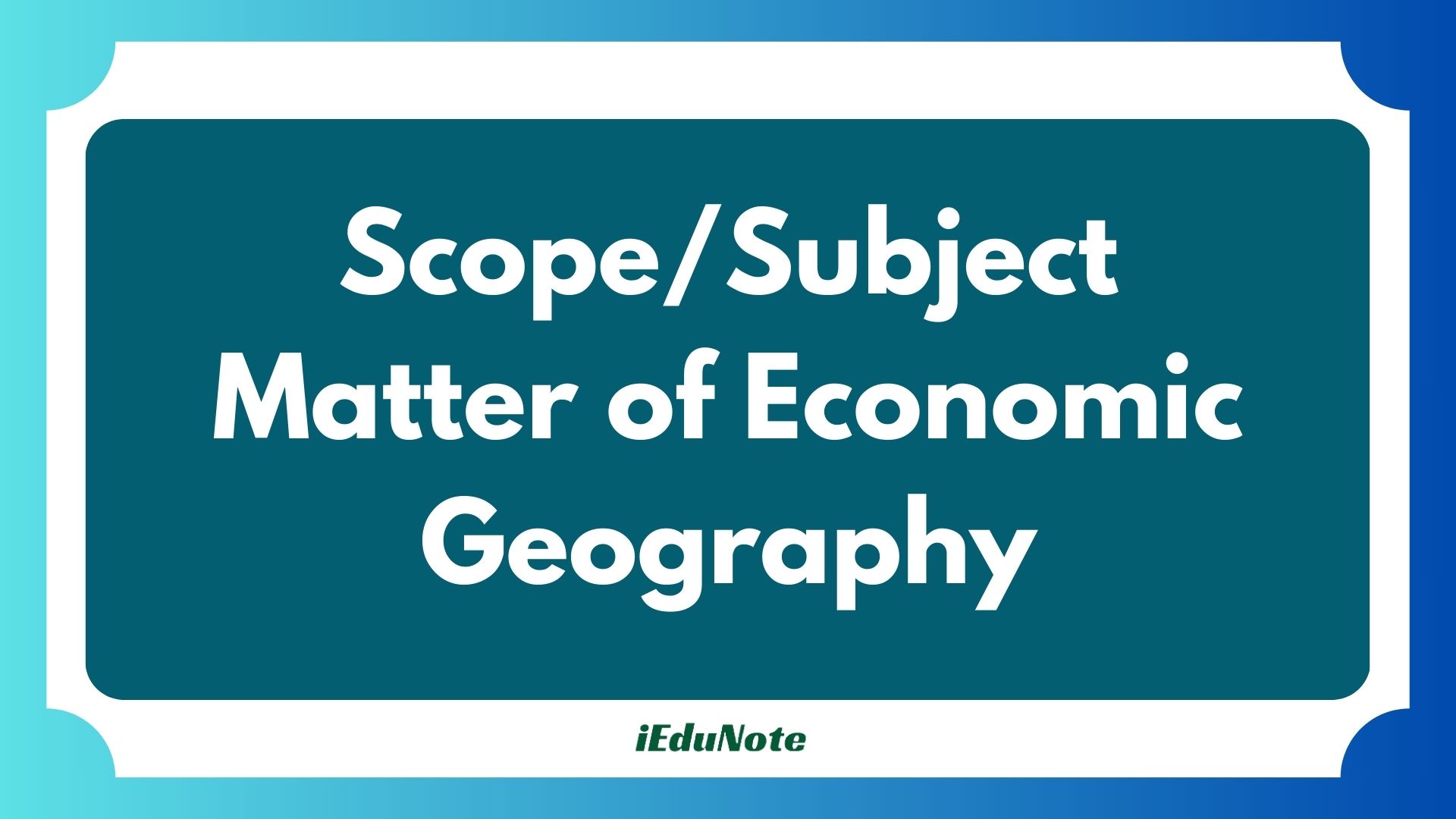
Most geographers have defined the scope and method of economic geography in terms of three basic questions,
- (i) Where is the economic activity located?
- (ii) What are the characteristics of the economic activity?
- (iii) To what other phenomena is the economic activity related?
- To these three later studies have added two more:
- (iv) Why is the economic activity located where it is?
- (v) Would it not be better located elsewhere, to better satisfy certain economic and social criteria?
And more recently an answer has been given that these are the result of economic behavior. This changing nature and change in emphasis on the content of the study shows that economic geography has proved the importance in various periods of its growth.
Therefore, it is necessary to discuss the nature and scope of economic geography both from the traditional to the modern point of view.
As early as 1882, the German scholar, Gotz had defined economic geography as “a scientific investigation of the nature of world areas in their direct influence of goods”.
Although Gotz initiated the concept of economic geography, his influence was limited to Germany only.
The abstract principles of that time could not be related to economic geography because they were not in their developed form. Economic geography owes its growth as an academic discipline to the interest of the British people in commerce.
It is interesting to note that George Chisholm, the father of modern economic geography, had wanted an intellectual interest in the study of geographical facts relating to commerce.
He thought that the primary use of economic geography is “to form some reasonable estimate of the future course of commercial development so far as that is governed by geographical conditions”.
In his treatment of the subject, however, Chisholm emphasized commercial development and considered the physical features and climate concerning products mainly.
This emphasis on physical features and climate of products led others subsequently to think of economic geography in terms of productive occupations.
Jones and Darkenwald (1950) state that, “Economic geography deals with productive occupations and attempts to explain why certain regions are outstanding in the production and exportation of various articles and why others are significant in the importation and utilization of the things.”
On the other hand, Ellsworth Huntington (1940), however, considers that all sorts of materials, resources, activities, customs, capabilities, and types of ability that play a part in the work of getting a living are the subject matter of economic geography.
Bengston and Van-Royen (1957), in their book Fundamentals of Economic Geography, have stated that: Economic geography investigates the diversity in basic resources of the different parts of the world. It tries to evaluate the effects that differences of physical environment have upon the utilization of these resources.
It studies differences in economic development in different regions or countries of the world.
It studies transportation, trade routes, and trade resulting from this different development and as affected by the environment.
Approaches to the Study of Economic Geography
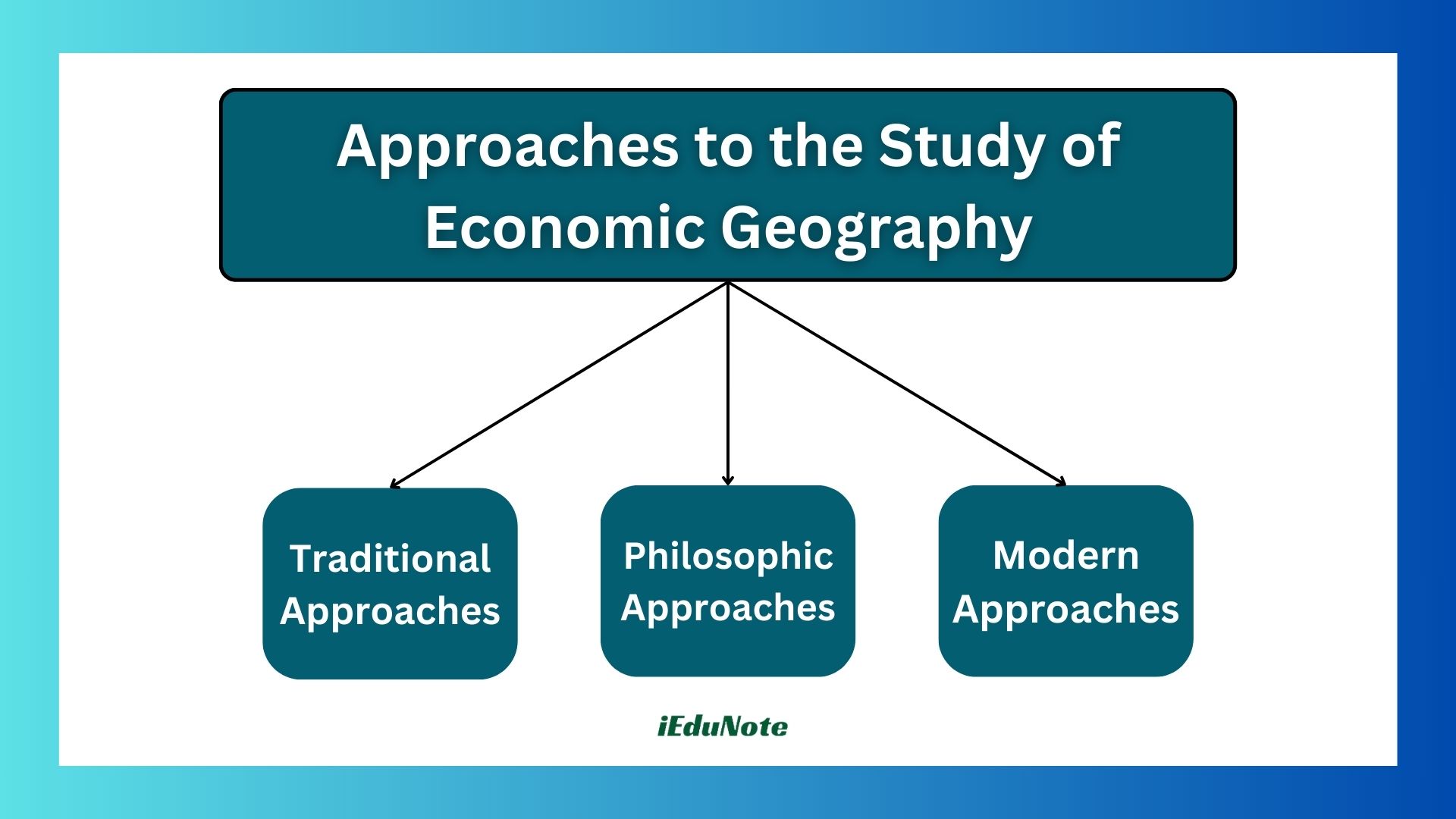
The approaches to study economic geography can be divided into three categories:
- Traditional Approaches
- Philosophic Approaches
- Modern Approaches
Traditional Approaches
These are the approaches that are common in geography and frequently used in economic geography. These are:
- Regional Approach,
- Commodity or Topical Approach, and
- Principles Approach.
Regional Approach
The term ‘region’ is very popular in geographical literature and refers to a suitable areal unit, e.g., a climatic region, a natural region, an industrial region, an agricultural region, an administrative or political region, and so on.
the region has common geo-economic characteristics, a resource base, economic development, and to some extent similarities in culture and demographic structure.
Therefore, several geographers have chosen this regional approach in economic geography. An advantage of the regional approach is that it gives a better knowledge of different parts of a unit, their relationship to each other, and to the unit as a whole.
Commodity or Topical Approach
This approach provides a systematic description and interpretation of the world distribution pattern of a commodity (wheat), or an industry (cotton textile industry), or a human occupation (fishing). It analyzes the whole sequence of their development and catches them on their march to progression or retrogression.
Principles Approach
In every sphere of human activity, certain fundamental truths or principles hold good. The concepts of Economic Geography are through and through permeated with the same spirit whether we talk of Regional Economic Geography or Systematic Economic Geography.
Economic regions are based on certain fundamental principles, and similar is the case with the extraction of minerals (coals, iron ore, or diamond), the localization of industries (metal fabricating or textile industries), or the exchange of commodities.
Philosophic Approaches
The 1990s research in economic geography may be characterized by three major philosophic approaches. These are:
- Positivism,
- Structuralism, and
- Humanism.
Positivism
It employs the scientific method to interpret and understand issues in economic geography. The scientific approach is based on empirically verifiable and commonly agreed-upon evidence through replication of analytical results.
It involves informed hypothesis testing leading to empirical generalizations and law-like statements. GTS (Group Information System) is central to analytical and positivist approaches to geography in general and with especially numerous applications in economic geography.
Structuralism
In economic geography, structuralism posits that what we see in the world does not reveal the causes of what we see.
The structure of the economy cannot be directly observed, and we should therefore develop ideas and theories that will help us understand what we see and experience. While there is no way to directly test such theories, we can debate about them to achieve a better understanding.
Humanism
It is a part of the critique of positivism.
Humanistic economic geographers object to both positivism and structuralism on the basis that these approaches view people as responding mechanically to spatial and structural forces.
Modern Approaches
In economic geography, three approaches have been developed during the last three decades that can be considered as modern approaches. These are:
- System analysis,
- Behavioral approach, and
- Institutional approach.
System Analysis
A system is a set of identified elements so related that together they form a complex whole. System analysis is an approach or methodology rather than a philosophy or scientific paradigm.
Economic geographers utilize the system concept to better understand the component elements of some part of reality, and the relations between them.
The use of such a conception stresses the study of the whole as well as of the parts. Thus, the world economy can be regarded as a set of interlocking parts and sub-systems.
Behavioral Approach
The incorporation of the behavioral science outlook in geography is known as behavioralism. In economic geography, the behavioral approach now has become very common. Economic geographers study the overall results of economically-oriented behavior as they appear in the landscape.
In economic geography, the study of decision-making processes is an important aspect. The type of decision-making, which is the concern of economic geography, can be classified as problem-solving or behavioral decision-making with such results as new locations for shops, farms, or factories.
Similarly, the studies of consumer behavior, movement or trip behavior, etc. are considered to be important. The decision-making process and other aspects of behavioral analysis.
Institutional Approach
Ron Martin (2003) has emphasized the need for an institutional approach in economic geography. He stated that the form and evolution of the economic landscape cannot be fully understood without giving due attention to the various social institutions on which economic activity depends and through which it is shaped.
In other words, economic activity is socially and institutionally situated and it cannot be explained by reference to atomistic individual motives alone but has to be understood as enmeshed in wider structures of social, economic, and political rules, procedures, and conventions. It is the role of these systems, both formal and informal, which is the focus of an institutional approach to economic geography.
Classification of Economic Activity
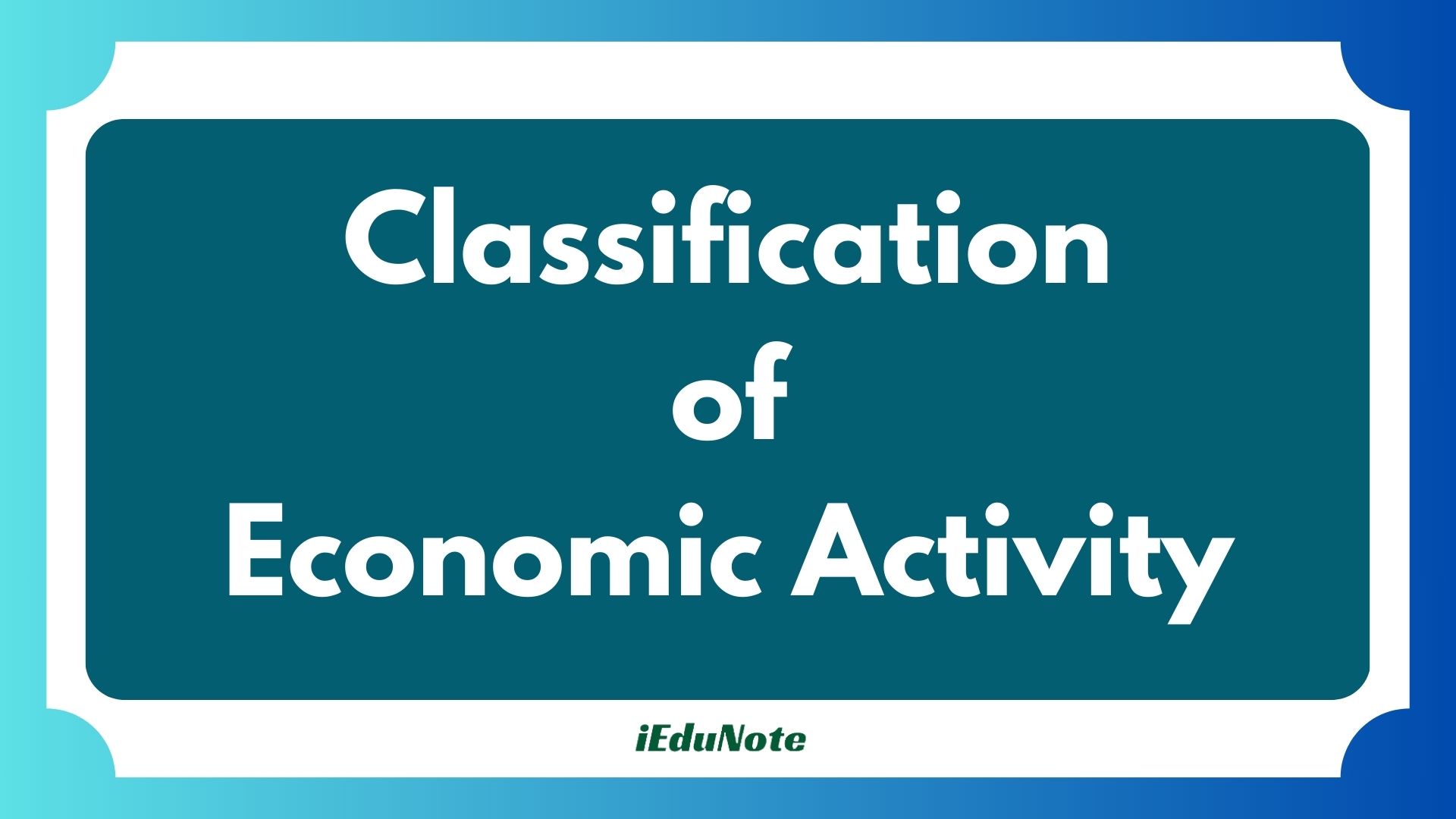
- The complex environmental and cultural realities control economic activities.
- Production patterns are rooted in the spatially variable circumstances of the physical environment.
- Resource disparity gives economic prospects in some regions and countries and employment opportunities.
- The recognition of resources or the ability to exploit them is affected by technological development.
- Political decisions may encourage or discourage economic activity (subsidies, protective tariffs, or production restrictions).
- Production is controlled by economic factors of demand, whether that demand is expressed through a free market mechanism, government instruction, or the consumption requirements.
Categories of Activity
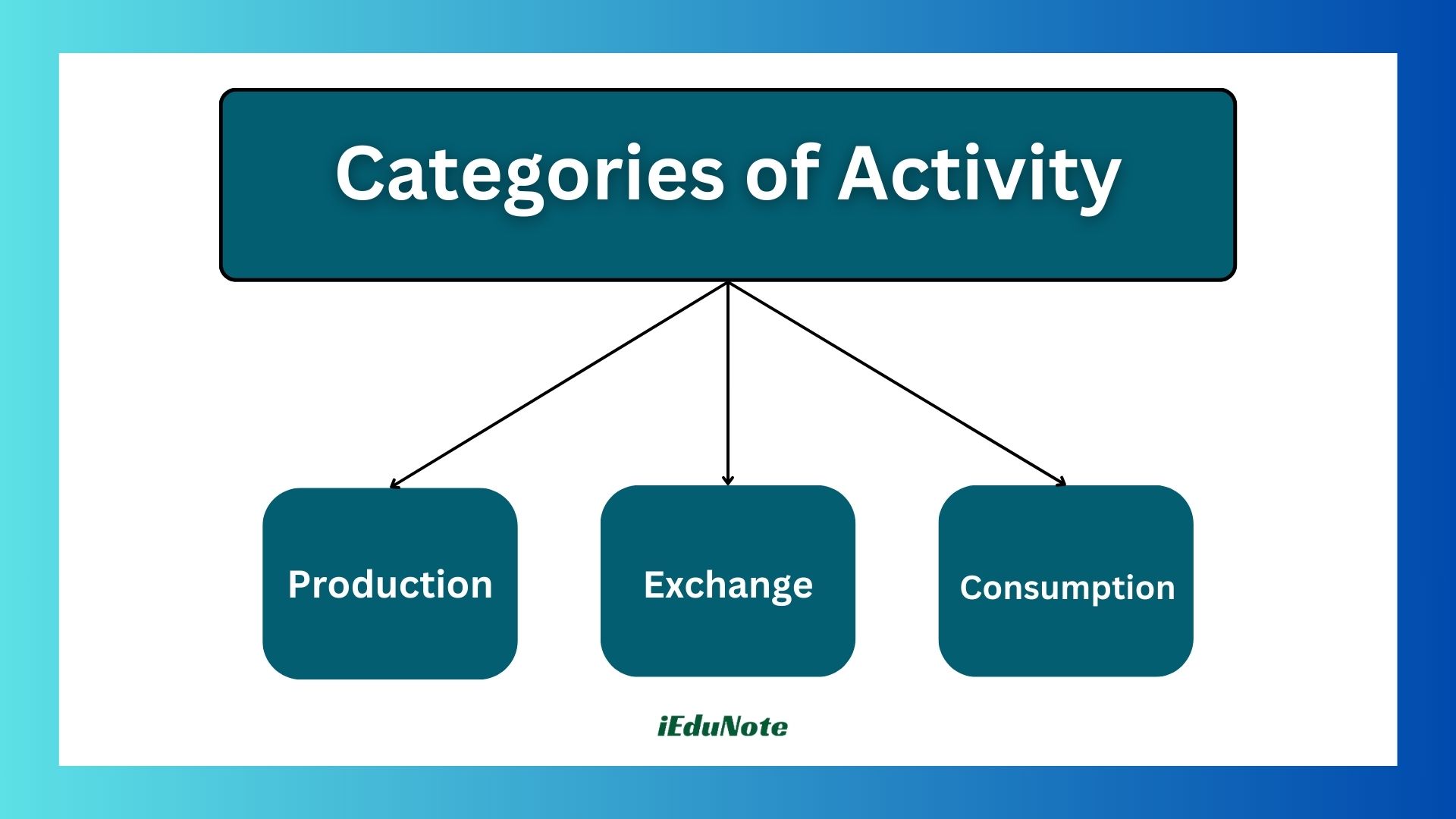
A. Production
The main sectors of the economy do not stand alone. They are connected and integrated by transportation and communication services and facilities not assigned to any single sector but not common to all.
Primary Activity
- Those parts of the economy involved in making natural resources available for use or further processing.
- They are mining, agriculture, forestry, fishing and hunting, and grazing.
Secondary Activity
- Economy involved in the processing of raw materials and altering or combining materials enhance utilities and value.
- They are Handicraft production, Woodenware, Copper smelting, Textile and chemical industries, Manufacturing and processing industries, Construction industry, and power production.
Tertiary Activity
- It includes wholesale and retail trade, associated transportation, and governmental services.
- This part fulfills the exchange function, provides market availability of commodities, and brings together consumers and providers of services.
Quaternary Activity
- It includes research with gathering and dissemination of information.
- It also is the administration of the other economic activity levels, often considered as a specialized subdivision of tertiary activities.
They are ‘white-collar’ professionals working in education, government, management, information processing, and research.
Quinary Activity
- A sometimes separately recognized subsection of tertiary activity management functions involving the highest-level decision-making in all types of large organizations.
B. Exchange
- Increasing the value of commodities by changing their location
- Exchanging services and ideas by telecommunication or face-to-face contact
- Satisfying the needs of people by changing their location (Passenger transportation)
- Warehousing and distribution function
- Wholesale trade
- Retail trade
C. Consumption
Use of commodities and services by human beings to satisfy needs and wants.
Population and Development Issues in the Developing World
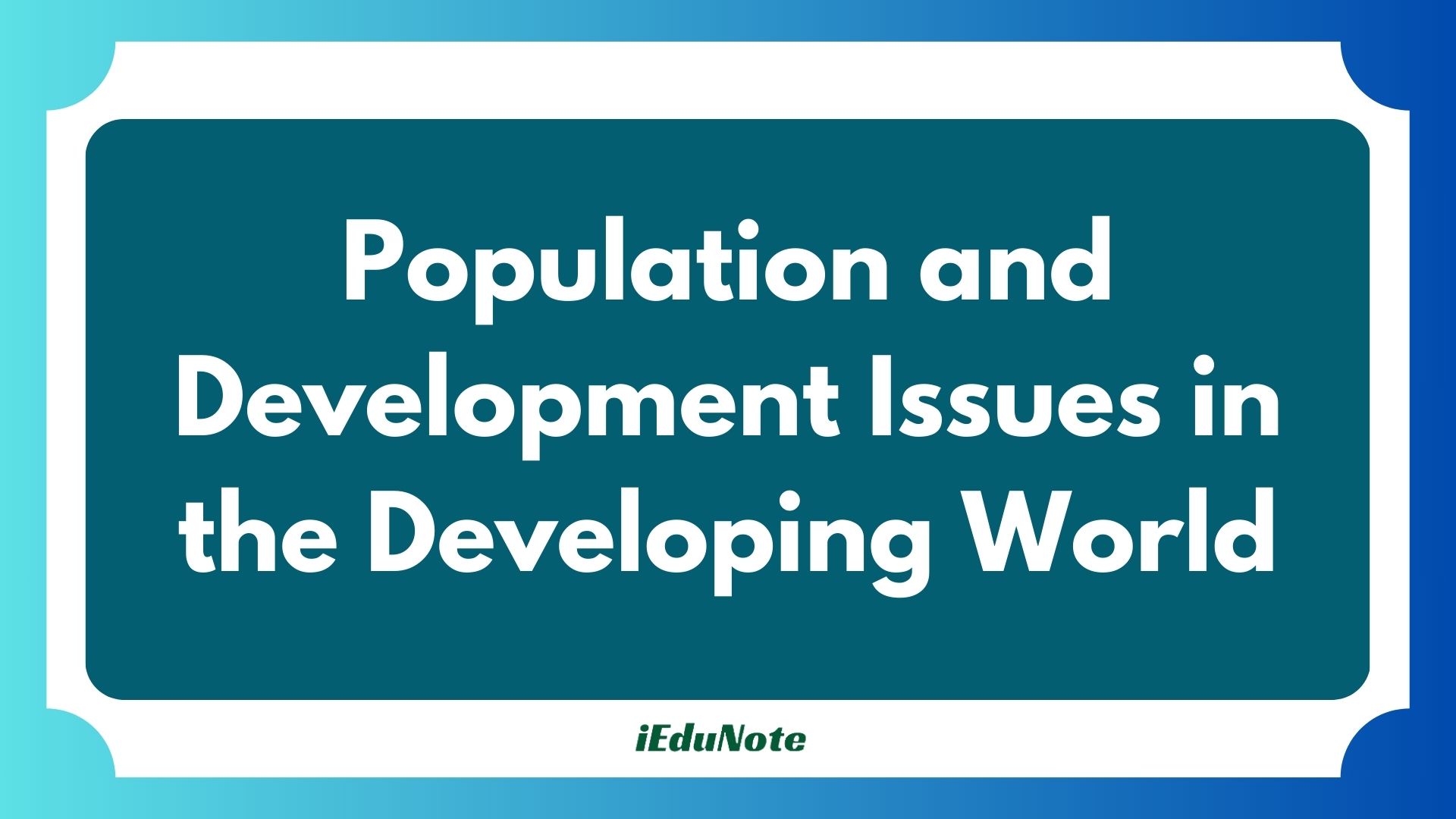
The well-being of approximately three-fourths of the world’s population – the poverty-ridden peoples in the underdeveloped countries of Asia, Africa, and Latin America – remains a significant and growing world problem.
It is indeed sobering that two centuries after the Industrial Revolution, most of the world remains poor, still suffering from inadequate standards of living.
Issues of population and development in the developing world context are interrelated mainly because of the circular relationship between population and development.
Population is both the subject and the basis of development. That is, development is directed at improving the socioeconomic well-being of the population and at the same time requires people for its technical and manual labor power.
It should be kept in mind that population, although necessary to get the process of development moving forward, can also stifle development meant to help itself.
Regardless of the nature of the relationship, the overriding issues of population and development in the developing world involve poverty, unemployment, underemployment, inequality, malnutrition, poor sanitation, and many other social miseries.
Dudley Seers (Meaning of development) has asserted that a country cannot be considered developed or developing unless it has been able to reduce the levels of poverty, unemployment, and socioeconomic inequality affecting its population.

